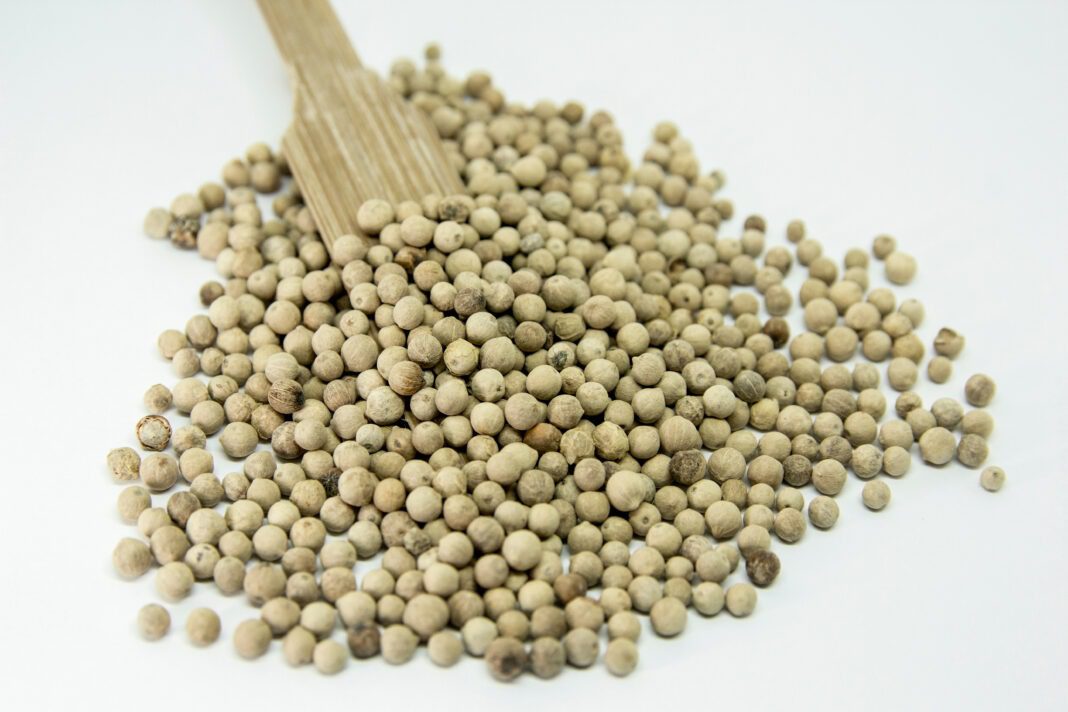Introduction
White pepper (Piper nigrum; family Piperaceae) is produced from black pepper by removing the outer skin. It is a common spice for at least 3,000 years, used in European, Chinese, Vietnamese, Thai cuisines. The flavor of white pepper is milder, sweet, and warmly aromatic than that of black pepper and mainly used in fish, meat, instant noodles, soups, mash potatoes, sauces, sandwiches, salad dressing, and mayonnaise. White pepper health benefits are it is anti-inflammatory, antioxidant, antimutagenic, and antitumor activities (1).
Common name and Distribution of White pepper
Common name
Safed Mirch, Milagu, Madagascar pepper, Guyue, and Baichuan
Geographical distribution
It is native to the tropical and subtropical regions, commercial production of white pepper is in India, Indonesia, Malaysia, Thailand, Africa, Brazil, Sri Lanka, Vietnam, and China.
Nutritional value of White pepper
According to the United States Department of Agriculture (USDA), white pepper is an important source of nutrients such as Protein, carbohydrates, minerals, vitamins, magnesium, manganese, and dietary fibers (2).
| Compound | Amounts per 100 g. |
| Water | 11.42 g |
| Energy | 296 Kcal |
| Protein | 10.4 g |
| Total lipid (fat) | 2.12 g |
| Carbohydrate | 68.61 g |
| Fiber, total dietary | 26.2 g |
| Calcium | 265 mg |
| Iron | 14.31 mg |
| Magnesium | 90 mg |
| Phosphorus | 176 mg |
| Potassium | 73 mg |
| Sodium | 5 mg |
| Zinc | 1.13 mg |
| Copper | 0.91 mg |
| Manganese | 4.3 mg |
| Vitamin C | 21 mg |
| Thiamin | 0.02 mg |
| Riboflavin | 0.13 mg |
| Niacin | 0.21 mg |
| Vitamin B-6 | 0.1 mg |
| Folate, DFE | 10 µg |
| Fatty acids, total saturated | 0.62 g |
| Fatty acids, total monounsaturated | 0.79 g |
| Fatty acids, total polyunsaturated | 0.62 g |
White pepper also contains oleoresin, piperine, and essential oil in which piperine is the major bioactive component that contributes to its pungency and biting taste. Moreover, the essential oil of white pepper is slightly less than black pepper. It contains monoterpenes, Sesquiterpenes, β –caryophyllene, and other components as follows (3,4).
| Nutrients | Percentage |
| Oil content | 74.42 % |
| Monoterpene | 7.0% |
| Sesquiterpenes | 79.0 % |
| β -caryophyllene | 70.4% |
| β-Selinene | 7.38 % |
| Aromadendrene | 5.30 % |
| β-elemene | 5.22 % |
| cis-piperitol | 5.21% |
| cis-β-guaiene | 4.67 % |
| ylangene | 3.70 % |
| 3-heptadecene | 3.55 % |
| δ-cadinene | 3 % |
| β-cadinene | 2.87 % |
White pepper health benefits
White pepper health benefits are mainly because of the compound piperine which is anti-inflammatory, antibacterial, and improves digestion.
1. Treat inflammatory disorder
White pepper with turmeric acts as a natural alternative for the treatment of inflammatory disorders like reduced liver lipid peroxidation which occurs due to obesity. The essential oil of white pepper reduces inflammatory and peripheral inflammatory pain and plays an important role in the inflammation of stroke (5).
2. Increase the bioavailability of the drug
Piperine (20 mg/kg) found in white pepper increase the bioavailability (2000 %) of curcumin (2 g/kg) by enhances the serum concentration, extent of absorption with no adverse effects in both animal and humans (6).
3. Treat cognitive impairment
Pepper and cinnamon combination has the ability to improve cognitive performance because it contains piperine and cinnamaldehyde which act as a thermogenic compound to treat cognitive impairment caused by exposure to cold (7).
4. Treat diarrhea
White pepper powder (stir-fried) is beneficial to decrease the frequency of diarrhea in infants and children due to the presence of piperine. The smell penetrates into the human body through the skin and increases the temperature of the bowel for adjusting the balance of the human body (8).
5. White pepper treats cerebral ischemia injury
White pepper contains piperine which acts as an anti-inflammatory and antioxidant agent that reduces brain damage by a reduction in oxygen-free radicals and protects against cerebral ischemia (9).
6. Anti-bacterial properties
Alkaloid, phenol, tannin, and coumarin like piperine, piperitin, piperidine, and chavicine act as antibacterial agents. It destroys DNA also cell wall synthesis of Streptococcus mutans. Thus white pepper inhibits the growth rate of Streptococcus mutans (10).
7. Improves digestion
Piperine obtains from white pepper stimulates the release of pancreatic and digestive enzymes such as pancreatic lipase, amylase, trypsin, and chymotrypsin (11). Moreover, white pepper also helps to shorten the transit time of food in the gastrointestinal tract (12).
8. Lowers blood pressure
White pepper contains piperine which shows a wonderful effect on lowering blood pressure and vasodilator effect (13).
Side effect of White pepper
1. Risk of diet-drug interaction
A research study suggested that oral intake of white pepper with extra puerarin decreases the oral absorption of puerarin may be due to diet-drug interactions thus precaution should be needed before consumption (14).
2. Risk of allergy
Some people face allergies with symptoms like urticaria, conjunctivitis, facial swelling, and severe cough immediately after ingesting pepper. Thus precaution should be needed before consumption (15).
3. Risk of rhinoconjunctivitis
White pepper may cause rhinoconjunctivitis symptoms due to continuous exposure in the food industry. Therefore precaution is needed because of hypersensitivity to white pepper (16).
4. More expensive and loose quality than black pepper
White pepper is four times more expensive than black pepper. In comparison to black pepper, white pepper decayed and loses its flavor very quickly (17).
Edited By: Dr. Asha Jyoti Bharati

[…] White Pepper Health Benefits – Click Here […]